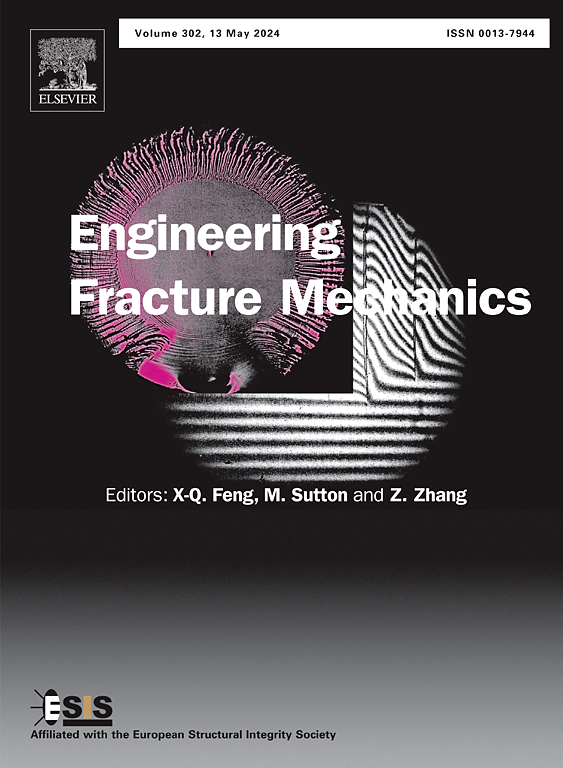Extension of the GISSMO fracture model for thin-walled structures under combined tensile and bending loads
IF 4.7
2区 工程技术
Q1 MECHANICS
引用次数: 0
Abstract
Ductile fracture prediction for thin-walled structures requires computationally efficient simulation tools able to approximately represent the key effects that occur on the sub-thickness scale. Unfortunately, classical shell elements, typically used to model deformation and failure of thin components, are inherently in a state of plane stress and therefore unable to capture the through-thickness stress distribution. This is consequential considering recent studies that demonstrated the differences between fracture in bending vs. in-plane tension. A laterally constrained thin metal plate under in-plane tension is likely to fracture under significantly lower plastic strain than the same plate under bending (with fracture initiating on the tensile side), even though both these conditions are examples of plane strain tension. Under in-plane tension fracture is preceded by a through-thickness neck, and therefore higher stress triaxiality than in the case of plane strain bending, where necking is absent. To account for these differences, we propose an extension of the GISSMO model, which relies on a simple fracture criterion based on stress-dependent fracture strain defined by the user (i.e. fracture locus). The fracture strain is typically determined experimentally using a combination of in-plane tensile tests under varying degree of lateral constraint and shear tests. The proposed extension involves defining a separate fracture locus for bending, also determined experimentally using bending tests. Fracture occurs when the equivalent plastic strain reaches its critical level represented by interpolation between the two bounding cases, i.e. bending and in-plane tension, with a bending index Ω used as an interpolation parameter.
在拉伸和弯曲综合载荷作用下薄壁结构的 GISSMO 断裂模型的扩展
薄壁结构的韧性断裂预测需要计算效率高的模拟工具,这些工具能够近似表示发生在亚厚度尺度上的关键效应。遗憾的是,通常用于模拟薄壁部件变形和断裂的经典壳元素本质上处于平面应力状态,因此无法捕捉到通厚应力分布。考虑到最近的研究证明了弯曲断裂与平面拉伸断裂之间的差异,这一点非常重要。在平面内受拉的横向约束金属薄板,其断裂时的塑性应变可能明显低于在弯曲状态下的同一块薄板(断裂始于受拉一侧),尽管这两种情况都属于平面应变拉伸。在平面拉伸条件下,断裂前会出现通厚颈,因此应力三轴性比平面应变弯曲条件下的应力三轴性要高,因为平面应变弯曲条件下不会出现颈缩。为了解释这些差异,我们提出了对 GISSMO 模型的扩展,该模型依赖于一个简单的断裂准则,该准则基于用户定义的应力依赖性断裂应变(即断裂位置)。断裂应变通常是通过实验确定的,结合使用不同程度横向约束下的面内拉伸试验和剪切试验。拟议的扩展包括定义单独的弯曲断裂位点,也是通过弯曲试验进行实验确定的。当等效塑性应变达到临界水平时,即发生断裂,该临界水平由两种约束情况(即弯曲和平面内拉伸)之间的插值表示,弯曲指数Ω用作插值参数。
本文章由计算机程序翻译,如有差异,请以英文原文为准。
求助全文
约1分钟内获得全文
求助全文
来源期刊
CiteScore
8.70
自引率
13.00%
发文量
606
审稿时长
74 days
期刊介绍:
EFM covers a broad range of topics in fracture mechanics to be of interest and use to both researchers and practitioners. Contributions are welcome which address the fracture behavior of conventional engineering material systems as well as newly emerging material systems. Contributions on developments in the areas of mechanics and materials science strongly related to fracture mechanics are also welcome. Papers on fatigue are welcome if they treat the fatigue process using the methods of fracture mechanics.

 求助内容:
求助内容: 应助结果提醒方式:
应助结果提醒方式:


